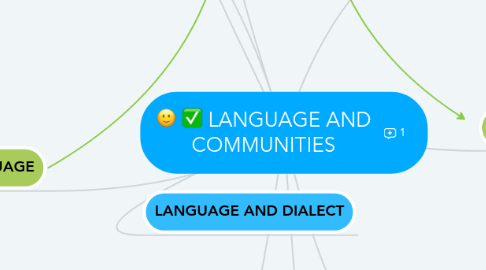
1. VARIETIES
2. LANGUAGE
2.1. Some unitary system of linguistic communication which subsumes number of mutually intelligible varieties
2.1.1. What distinguish certain language from others (Criterions)
2.1.1.1. Standarization
2.1.1.1.1. Codification of language
2.1.1.2. Vitality
2.1.1.2.1. Existence of a living community of speakers
2.1.1.2.2. Distinguishes languages that are "alive" from those that are "dead"
2.1.1.3. Hitoricity
2.1.1.3.1. Group of people that finds a sense of identity through using a particular language
2.1.1.4. Authonomy
2.1.1.4.1. A language must be felt by its speakers to be different from other languages
2.1.1.5. Reduction
2.1.1.5.1. A particular variety may be regarded a a sub-variety rather than an undependent entity
2.1.1.6. Mixture
2.1.1.6.1. The feeling speakers have about the purity of the variety they speak
2.1.1.7. De facto norms
2.1.1.7.1. Means focusing on one particular sub-variety a representing the best usage
3. Each language exits in a number of varieties
4. Set of linguistic items or human speech pattern
5. LANGUAGE AND DIALECT
6. Relationship
6.1. Power
6.1.1. requires asymmetrical relationship between entities
6.1.1.1. Status Money Influence
6.1.1.1.1. A language has more power than any of its dialect
6.2. Solidarity
6.2.1. Feeling of equality between people
6.2.1.1. can lead a group to conserve a local dialect
6.2.1.1.1. Modernization of Hebrew Separation of Herbo-Croatian Local dialect
7. DIALECT
7.1. Form of speaking a language in a group of people (community)
7.1.1. A local variety of a real language
7.2. Used
7.2.1. local varieties of English
7.2.1.1. Yorkshire dialect
7.2.2. Informal Lower-class Rural speech
8. To this is called
9. Diferences
9.1. Language refers to a single linguistic norm or a group of related norms, and dialect refers just to one of the norms
9.2. China speak diferent language (Catonee and Mandarin)
9.2.1. They don't understand themselves oraly, but written
9.2.2. They speak different dialects of Chinese, not different language
9.3. Language is bigger than dialect or variety
9.3.1. Process of divergence and convergence
9.3.1.1. Language and dialect differences become further obscured
9.3.1.1.1. Many speakers are also likely to be multilingual
10. Language and dialect situation
10.1. Border between the Netherland and Germany
10.1.1. There was a continuum of dialects of language ( historically)
10.1.1.1. They are not mutually intelligible
